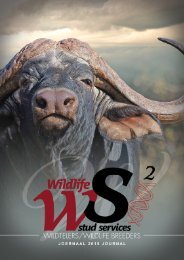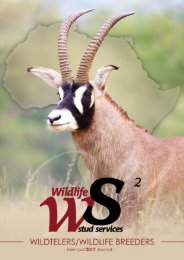Wildlife Breeders Journal 2016
The second edition of the well renowned Wildlife Breeders Journal published by Wildlife Stud Services in South Africa.
The second edition of the well renowned Wildlife Breeders Journal published by Wildlife Stud Services in South Africa.
Create successful ePaper yourself
Turn your PDF publications into a flip-book with our unique Google optimized e-Paper software.
eeding<br />
culminated in a new profitable form of<br />
land use: game farming. This activity on its<br />
own has shown that it can succeed and has<br />
been compared to a diamond, thus having<br />
many facets. Examples thereof are tourism,<br />
hunting, research and the production of byproducts<br />
such as biltong, venison and hides<br />
(Young, 1992).<br />
Through an evolutionary process, game<br />
farming has become more focussed in<br />
certain instances leading to intensive wildlife<br />
production. As wildlife production increases,<br />
more rare animals are entering the market,<br />
with major economic and conservation<br />
impact. In extensive production systems<br />
the growth rate of rare wildlife populations<br />
is often retarded. Recent realisation that<br />
such animals can be intensively produced<br />
economically and practicably feasible,<br />
provided new stimulus and input into wildlife<br />
production in southern Africa (Bothma & van<br />
Rooyen, 2006).<br />
There is a growing demand for a diversity<br />
of species in the <strong>Wildlife</strong> Ranching and<br />
Ecotourism Industry. The smaller antelope<br />
have, however, been neglected to date and<br />
their numbers have probably declined in<br />
several areas. Various reasons can be given<br />
for this, one of which is the fact that very<br />
few of these animals are made available to<br />
interested buyers and the breeding of these<br />
species has thus not been tried on and tested<br />
commercially. By now it has been proven by<br />
other species that the most reliable way of<br />
ensuring the future existence of any species<br />
lies in attempts to create a monetary value for<br />
each of them, which in turn should motivate<br />
farmers to breed them, thereby ensuring the<br />
distribution and natural increase in their<br />
population numbers.<br />
animals on land suitable for development<br />
can simply be removed and put into a<br />
captive breeding facility. This may ultimately<br />
work against the objectives of small antelope<br />
conservation, especially considering that<br />
the success of rehabilitation of captive bred<br />
animals into the wild has not been well tested.<br />
Captive breeding must therefore only be seen<br />
as a management tool to ultimately support<br />
the return of animals into natural habitat,<br />
and must not be seen as a conservation tool<br />
in isolation to conserving small antelope<br />
species in their natural habitats.<br />
Source animals are from (1) a population<br />
that is ‘doomed’ i.e. population is under<br />
imminent threat of extinction due to land use<br />
change or poaching, and where there are no<br />
options for natural movement of animals to<br />
contribute to a larger meta-population, (2) a<br />
population at or above maximum productivity<br />
carrying capacity (i.e. at or above 75% of<br />
ecological carrying capacity) or a level at<br />
which Provincial conservation agencies are<br />
prepared to grant a capture permit, or (3)<br />
animals that are injured or imprinted and are<br />
hence non-releasable.<br />
• The purpose is to ensure that there are no<br />
extra negative impacts on wild populations;<br />
it is undesirable to remove animals from<br />
wild populations where these populations<br />
are below carrying capacity, or where<br />
options exist to translocate animals to<br />
other areas of natural habitat.<br />
• In all cases status of populations (doomed<br />
populations, populations above maximum<br />
productivity carrying capacity, and nonreleasable<br />
animals) is to be assessed by an<br />
authorised representative.<br />
The main objective of the Small Game<br />
<strong>Breeders</strong> Association SA (SGBASA) is to<br />
promote the conservation of all the small<br />
antelopes in their natural habitats. One of the<br />
biggest threats to small antelope species is<br />
habitat loss and fragmentation. While captive<br />
breeding may contribute towards achieving<br />
the goals of the SGBASA, there is also a risk<br />
that providing captive breeding as an option<br />
will result in more land transformation and<br />
habitat loss based upon the perception that<br />
25





